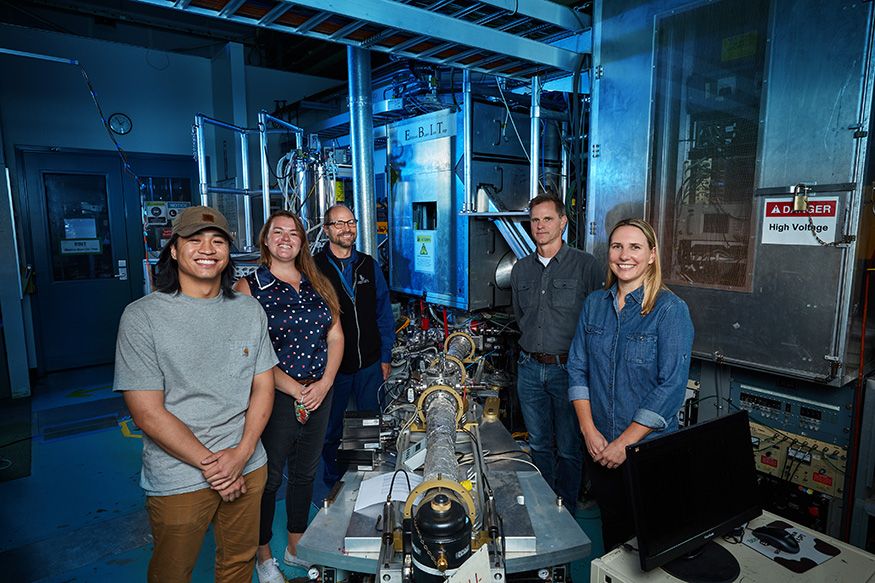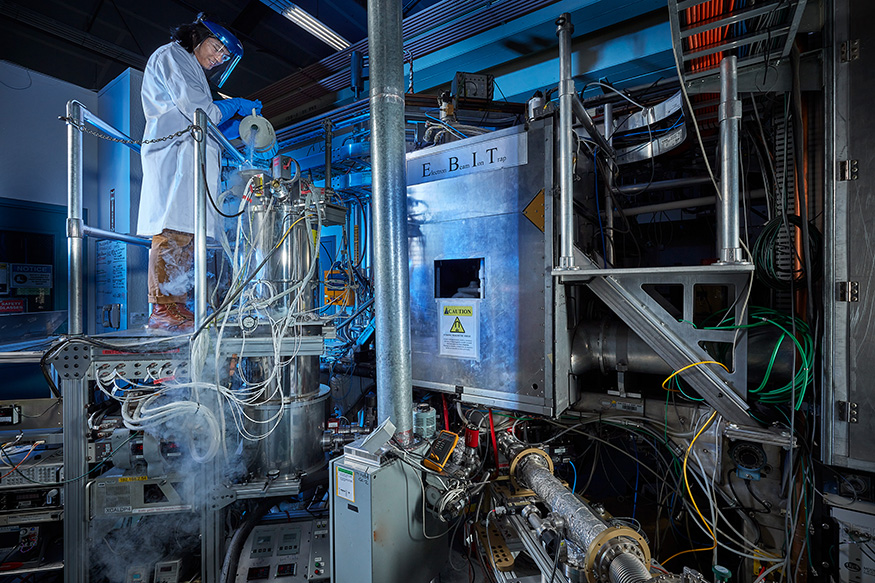X-ray and laboratory astrophysics
Researchers at Lawrence Livermore perform experiments using laboratory facilities and space-based observatories to address fundamental questions in x-ray astrophysics.
Developing and applying high-resolution x-ray spectroscopy
X rays from astrophysical objects provide a view into some of nature’s most violent and extreme environments. Telescopes sensitive to the x-ray waveband (0.1−100 kiloelectronvolts, or keV) provide unique probes of accreting black holes and the warped spacetime around them, clusters of galaxies—the universe’s most massive gravitational potential wells—and the growth and evolution of galaxies.
To unravel the physics governing these sources, researchers not only want to take images in the x-ray band, but they also want to know the precise energy of every photon in the image. Imaging spectroscopy allows the use of spectroscopic plasma diagnostics to learn details about these systems, such as their temperature, velocity, composition, and mass distributions.
At LLNL, we have been working to advance x-ray spectroscopic capabilities and the associated plasma diagnostics for astronomy for several decades. Our team works on instrument development and science teams for x-ray astrophysics missions and leads x-ray laboratory astrophysics investigations. Our work receives funding from the NASA Astrophysics research program to support the general x-ray astrophysics community, and is funded directly to support the X-ray Imaging and Spectroscopy Mission (XRISM), an x-ray observatory that will launch in 2023, and the Athena X-ray Integral Field Unit (X-IFU).
Our work in x-ray astrophysics at LLNL falls into several overlapping areas:
Laboratory astrophysics experiments at the LLNL electron beam ion trap (EBIT) facility and at other facilities worldwide
Instrument development and calibration for future astrophysics missions, including XRISM and Athena
Observational astrophysics using existing observatories
Space mission concept development
Benchmarking spectral modeling code to enable precision measurements
Our laboratory astrophysics program centers around LLNL’s electron beam ion trap (EBIT) facility, which currently includes the EBIT-I and SuperEBIT. Invented and developed by LLNL researchers, EBIT allows high-accuracy measurements of x-ray emission from isolated, highly charged ions to derive atomic physics parameters needed for the interpretation of complex spectra. It operates in the coronal density limit, with electron densities of about 5 x 1011 per cubic centimeter. These conditions are perfectly suited for astrophysics-related studies.
LLNL’s EBIT facility has a full suite of x-ray and extreme ultraviolet (EUV) spectrometers to aid in diagnosing the trap conditions and measuring the photon emission from the trapped ions. The instruments include grating and crystal spectrometers for very high resolution (about 0.1 eV) measurements, as well as microcalorimeter spectrometers for moderate resolution (about 5 eV) with a broad waveband.
Our laboratory astrophysics measurements help benchmark the leading spectral modeling packages used by the high-energy astrophysics community, such as:
- The Atomic Database for Astrophysicists (AtomDB), maintained at the Harvard–Smithsonian Center for Astrophysics (CfA)
- SPEX, maintained at the Netherlands Institute for Space Science (SRON)
- CHIANTI, maintained at the University of Michigan, George Mason University, the University of Cambridge, and NASA Goddard Space Flight Center
- CLOUDY, maintained at the University of Kentucky
LLNL scientists are actively engaged with the astrophysics community to address high-priority questions and with the teams at CfA, SRON, and other institutions to ensure the measurements are properly incorporated into the databases and spectral modeling codes.
Lawrence Livermore is home to many students and visiting researchers from institutions around the world who perform experiments at the EBIT facility. We also partner with researchers to perform laboratory astrophysics experiments at other facilities, including experiments coupling portable EBITs to synchrotrons and free-electron lasers.
Developing and calibrating microcalorimeter instruments for space-based astronomy
The coming generation of astrophysical x-ray missions, such as XRISM and Athena, will deploy arrays of x-ray microcalorimeters—a type of x-ray detector that operates at low temperature (50 mK) and is designed for high-energy resolution—to provide imaging spectroscopy. These detectors have an unprecedented combination of high spectral resolution and high quantum efficiency over a broad energy range (0.1–20 keV).
The EBIT facility is home to microcalorimeter spectrometers built by our colleagues at NASA’s Goddard Space Flight Center (GSFC) and used at LLNL for laboratory measurements. Conversely, Lawrence Livermore researchers are members of instrument teams developing microcalorimeter instruments for space missions, including Resolve on XRISM and the X-IFU on Athena.
Examples of our research activities include:
- Developing and deploying x-ray generating equipment for ground calibration.
- We refurbished and deployed an EBIT for Resolve calibration and are designing and building a more capable EBIT for X-IFU calibration. X-ray emission from highly charged ions produced in EBITs, such as helium-like oxygen and helium-like neon, provides a significant improvement in accuracy over characteristic lines produced by standard x-ray tubes often used for calibration purposes.
- We are developing optimized crystal and grating x-ray monochromators for X-IFU ground calibration.
- Supporting detector performance and calibration campaigns, from component-level laboratory testing to on-spacecraft system tests to in-orbit commissioning.
- Using DOE facilities such as synchrotron light sources to calibrate thin-film filters and x-ray absorbers.
- Working with software development teams to implement algorithms and incorporate calibration results for mission data processing software.
Observational astrophysics
Our researchers are engaged in observational astrophysics projects using Chandra and XMM-Newton and are preparing for the launch of XRISM. Our scientists lead target teams for observations to be made during the performance verification phase of the XRISM mission in 2023. We contribute to novel observations using payloads flown on sounding rockets, most recently the Micro-X Sounding Rocket.
LLNL expertise in x-ray plasma physics, atomic physics, and instrumentation position researchers to make key contributions to astrophysics using these new windows into the universe.
Instruments and techniques serving a dual purpose
Many of the high-resolution x-ray spectrometers at the LLNL EBIT facility have counterparts deployed to facilities around the world. In fact, several of these dispersive spectrometers were originally designed for magnetic fusion energy devices or high-energy-density laser experiments, calibrated using EBIT before being deployed, and then copied with minor modifications to enhance the laboratory astrophysics investigations at LLNL. Conversely, our group is working to adapt x-ray microcalorimeter spectrometers originally developed for astrophysics and in use for the last two decades at the EBIT facility to transform x-ray diagnostic capabilities for magnetic fusion energy experiments. Our team recently deployed the XRS/EBIT microcalorimeter spectrometer to the Madison Symmetric Torus (MST) at University of Wisconsin–Madison.
Image gallery
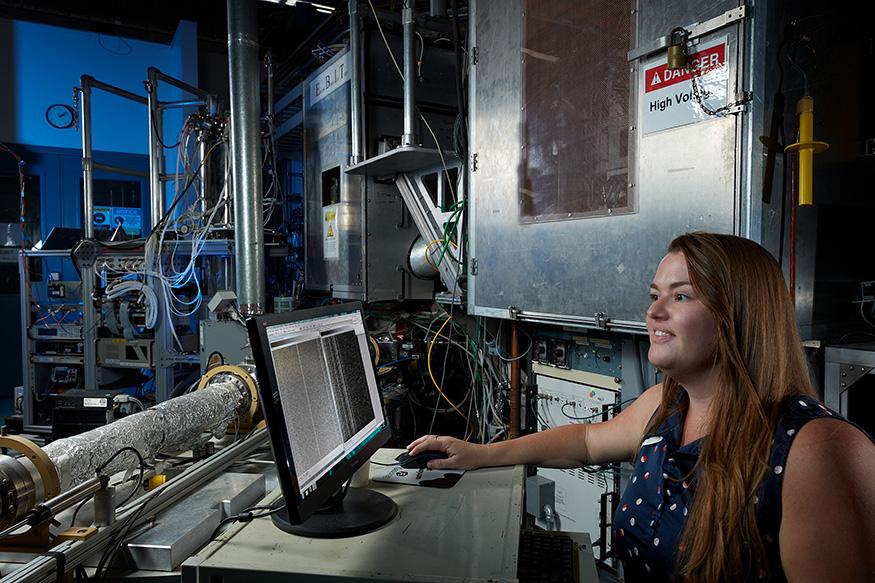

Antonia Hubbard checks data from the EBIT facility’s high-resolution x-ray grating spectrometer.
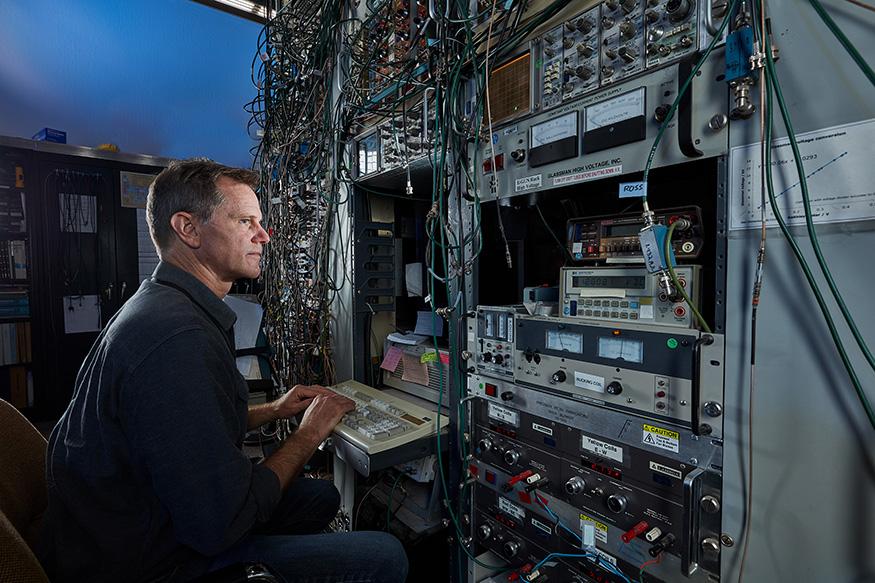

Greg Brown commands the EBIT control computer.
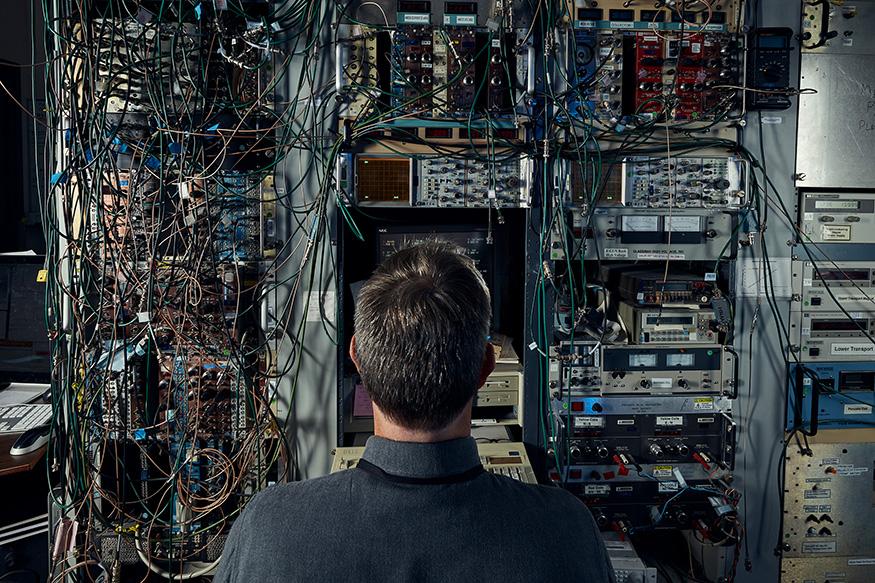

Greg Brown in front of the EBIT controls.
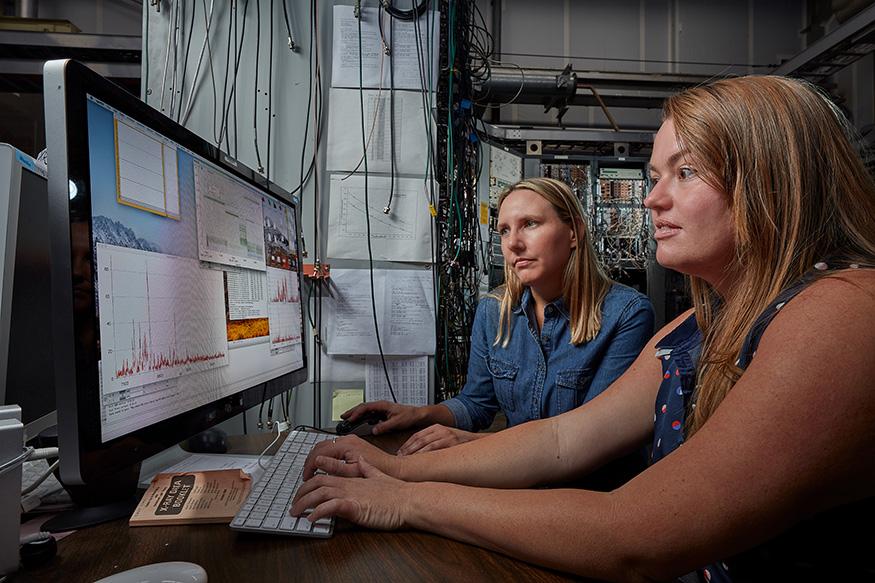

Researchers monitor the x-ray spectrum generated by the LLNL EBIT in real time using the EBIT Calorimeter Spectrometer.
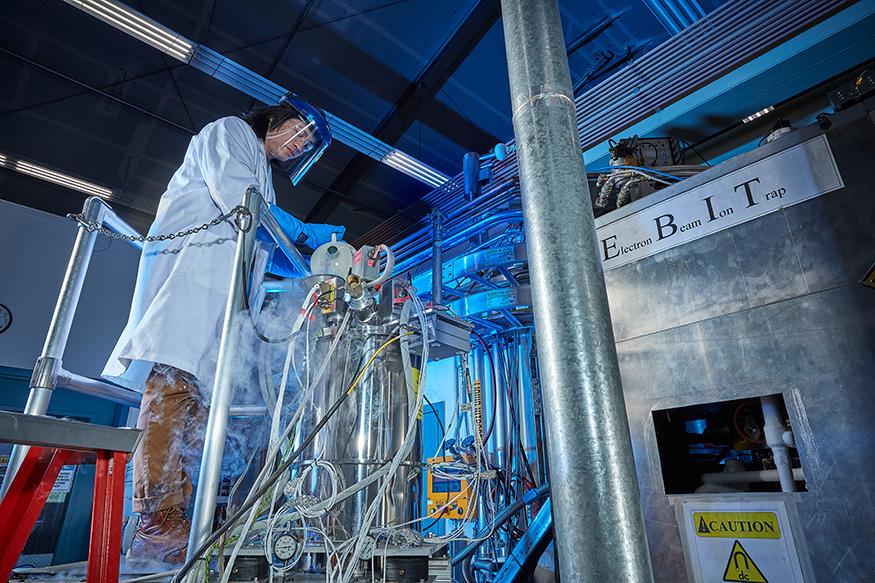

Harrison Flores-Alimboyoguen fills the EBIT Calorimeter Spectrometer with liquid nitrogen. A combination of nitrogen, helium, and a magnetic refrigerator cool the microcalorimeter detector to 50 mK. The EBIT itself sits behind the shielding on the right.
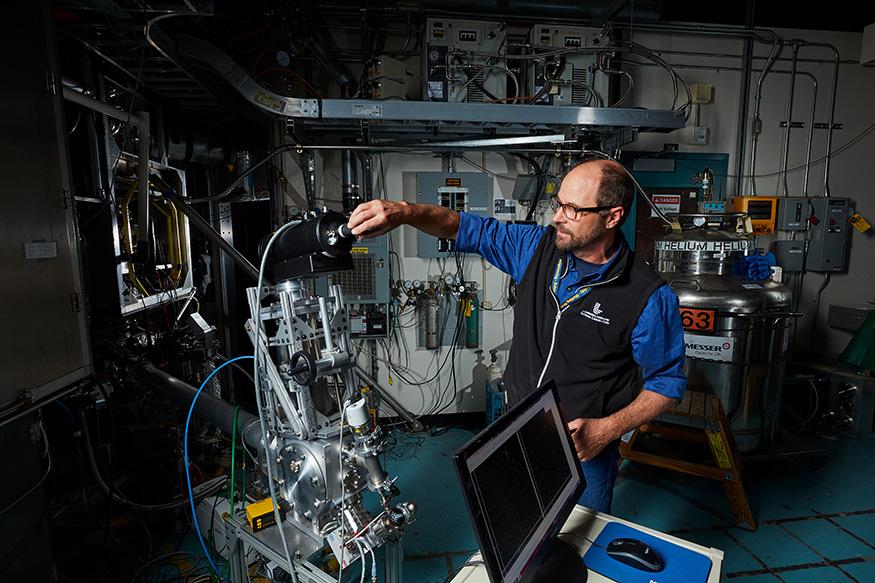

Ed Magee with a high-resolution crystal spectrometer. These spectrometers provide resolutions of better than 0.5 eV and can be configured to work from 0.5-10 keV. By attaching two copies of the spectrometer, one in a vertical orientation and one in a horizontal configuration, we perform polarization-resolved spectroscopy.
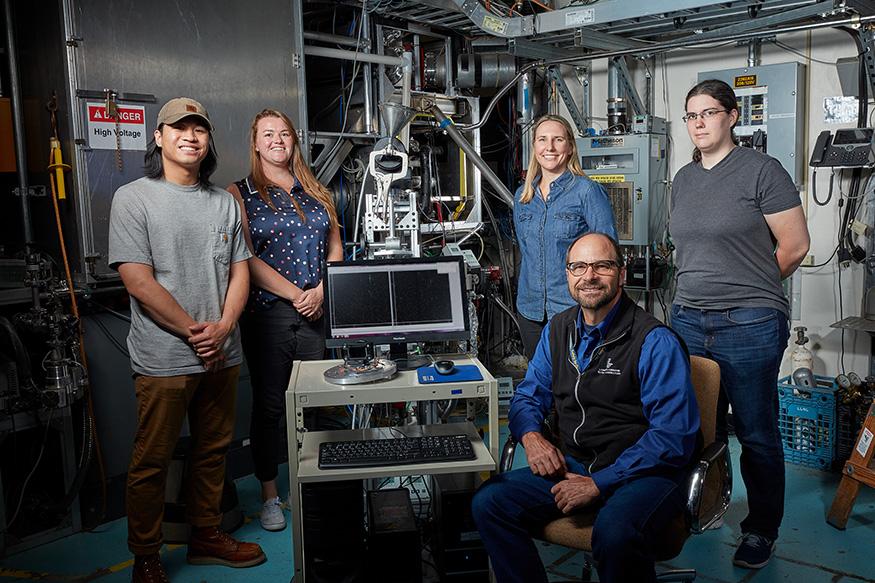

Left to right: Harrison Flores-Alimboyoguen, Antonia Hubbard, Megan Eckart, Ed Magee (sitting), and Natalie Hell stand as a high-resolution crystal spectrometer records an x-ray spectrum from the EBIT (visible in the background).
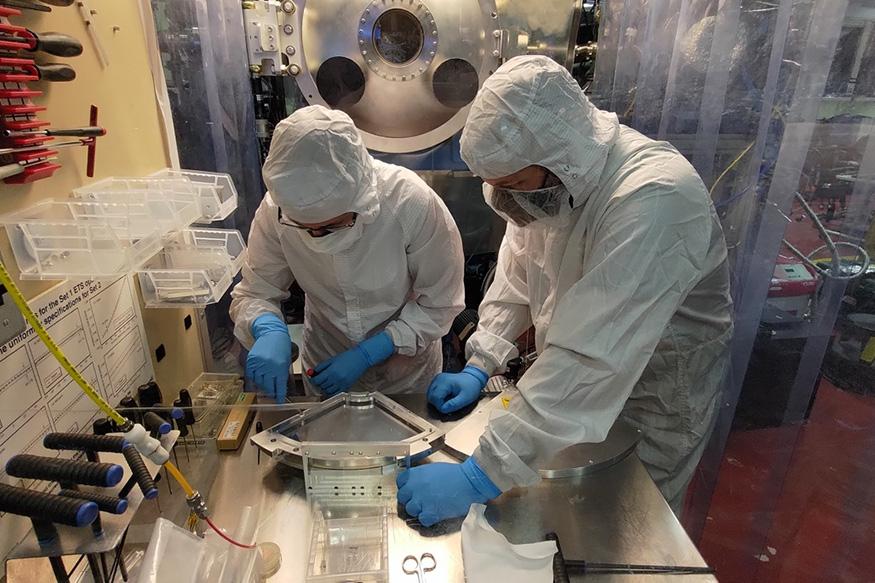

Megan Eckart (LLNL) and Maurice Leutenegger (NASA Goddard Space Flight Center) preparing to install a XRISM mirror thermal shield for x-ray transmission calibration measurements at the Lawrence Berkeley National Laboratory Advanced Light Source. The thin aluminized polyimide film must be calibrated to an accuracy of better than 2%.
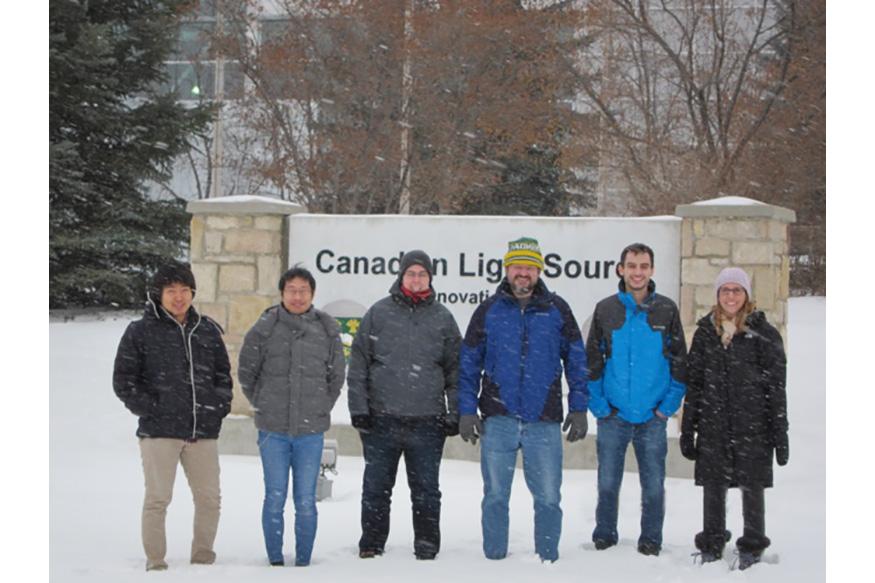

Lab researchers Natalie Hell (third from left) and Megan Eckart (right), joined by colleagues from NASA’s Goddard Space Flight Center and University of Waterloo, experience -40 degree weather at the Canadian Light Source (CLS) in Saskatoon, Canada in early 2019. This trip was one of several to CLS and the Advanced Light Source in Berkeley to calibrate filters and mirror thermal shields for the XRISM Resolve instrument.
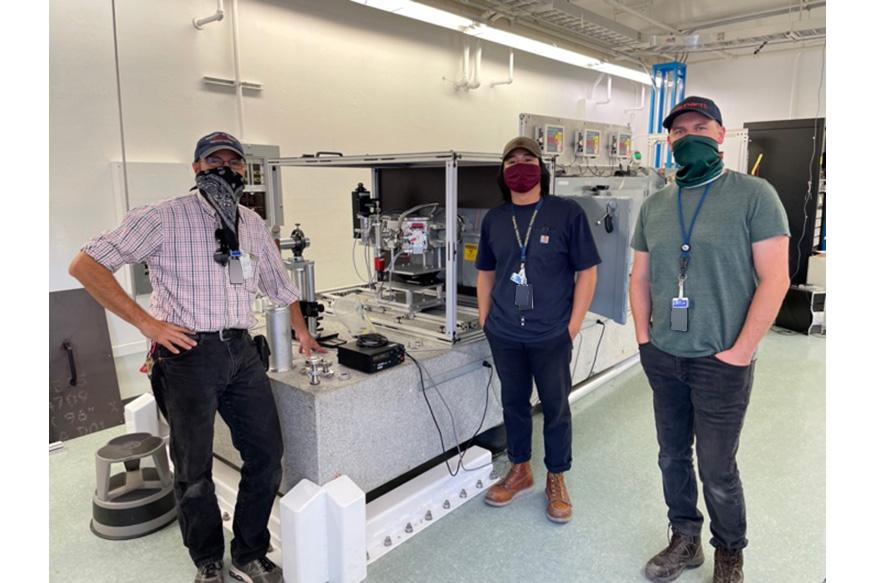

Ed Magee, Harrison Flores-Alimboyoguen, and Phil Hamilton with a high-resolution crystal spectrometer installed at the LLNL x-ray optics calibration facility for tests supporting the development of calibration equipment for Athena’s X-ray Integral Field Unit.
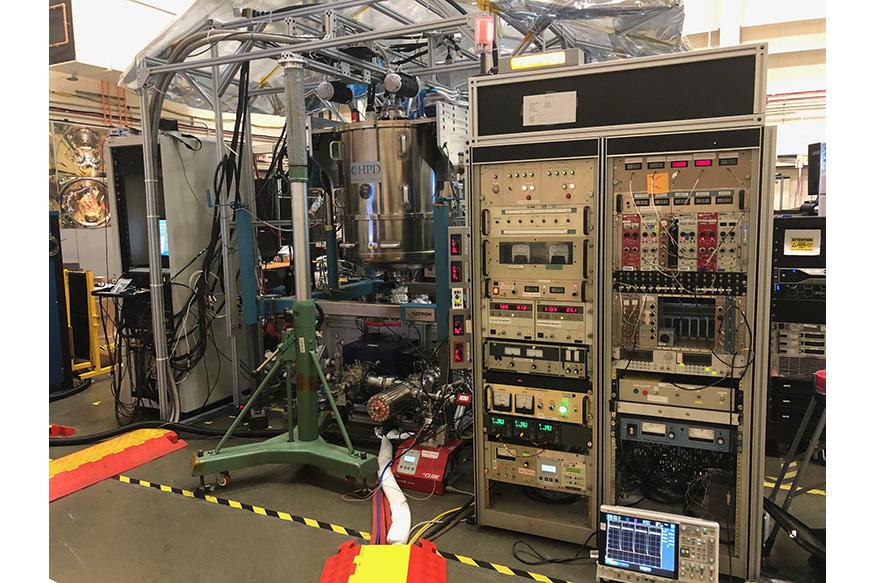

The LLNL Warm EBIT (WEBIT) installed beneath the XRISM Resolve performance dewar during calibration at NASA Goddard Space Flight Center in 2019. The WEBIT electronics rack is at the right.
People
| Name | Title | Discipline |
|---|---|---|
| Team | ||
Collaborators
| Institution | People | Area |
|---|---|---|
| UC Berkeley Space Sciences Laboratory (SSL) | Peter Beiersdorfer (LLNL ret.), Ming Feng Gu | Laboratory astrophysics, Flexible atomic code (FAC) |
| NASA Goddard Space Flight Center | X-ray calorimeter group, X-ray astrophysics laboratory | Laboratory astrophysics; XRISM Resolve and Athena X-IFU development and calibration, microcalorimeter systems, Micro-X |
| University of Erlangen-Nürnberg, Dr. Karl Remeis-Sternwarte Astronomical Institute | Joern Wilms group | Laboratory astrophysics, observational astrophysics |
| Harvard-Smithsonian Center for Astrophysics | High-Energy Astrophysics Division | Laboratory astrophysics, AtomDB, X-ray probe mission concept |
| Rikkyo University | Department of Physics | Laboratory astrophysics, XRISM Resolve |
| University of Wisconsin–Madison | Dan McCammon’s X-ray astrophysics group | Microcalorimeter data processing, XRISM Resolve, sounding rockets |
| University of Wisconsin–Madison | Wisconsin Plasma Physics Laboratory, Daniel Den Hartog | Laboratory astrophysics using microcalorimeter on the Madison Symmetric Torus |
| Northwestern University | Tali Figueroa group | Micro-X sounding rocket experiment |
| Japanese Aeronautics and Space Administration (JAXA) | Institute of Space and Astronautical Science (ISAS), and collaborating institutions in Japan | XRISM Resolve |
| National Centre for Space Studies (CNES), France | Directorate of Orbital Systems and Applications, Science of the Universe Division | Athena X-IFU |
| Institut de Recherche en Astrophysique et Planetologie (IRAP), France | Galaxies, High Energy Astrophysics, and Cosmology (GAHEC) | Athena X-IFU, laboratory astrophysics |
| Max-Planck Institute for Nuclear Physics | José Crespo López-Urrutia group | Laboratory astrophysics |
| Columbia University | Daniel Savin group | Laboratory astrophysics |
Select publications
For a complete list of related papers since 2010, see our ADS library.
First operation of transition-edge sensors in space with the Micro-X sounding rocket | Proc. SPIE, 2021
J.S. Adams et al, with M.E. Eckart and A.J.F. Hubbard
High-resolution Laboratory Measurements of K-shell X-Ray Line Polarization and Excitation Cross Sections in Helium-like S XV Ions | ApJ, 2021
C. Shah, N. Hell, A. Hubbard, M.F. Gu, M.J. MacDonald, M.E. Eckart, R.L. Kelley, C.A. Kilbourne, M.A. Leutenegger, F.S. Porter, G.V. Brown
Microcalorimeter measurement of x-ray spectra from a high-temperature magnetically confined plasma | RSI, 2021
M.E. Eckart, P. Beiersdorfer, G.V. Brown, D.J. Den Hartog, N. Hell, R.L. Kelley, C.A. Kilbourne, E.W. Magee, A.-E.Y. Mangoba, M.D. Nornberg, F.S. Porter, L.M. Reusch, and J.P. Wallace
Color-color diagrams as tools for assessment of the variable absorption in high mass X-ray binaries | A&A, 2020
V. Grinberg, M. A. Nowak, and N. Hell
High-Precision Determination of Oxygen Ka Transition Energy Excludes Incongruent Motion of Interstellar Oxygen | PRL, 2020
M.A. Leutenegger et al, with N. Hell and G. V. Brown
Highly charged ions in a new era of high resolution X-ray astrophysics | X-ray Spectrometry, 2020
N. Hell, P. Beiersdorfer, G.V. Brown, M.E. Eckart, R.L. Kelley, C.A. Kilbourne, M.A. Leutenegger, T.E. Lockard, F.S. Porter, J. Wilms
Status of x-ray imaging and spectroscopy mission (XRISM) | Proc. SPIE, 2020
M. Tashiro et al.
A High Spectral Resolution Study of the Soft X-Ray Background with the X-Ray Quantum Calorimeter | ApJ, 2019
D. Wulf, M.E. Eckart, M. Galeazzi, F. Jaeckel, R.L. Kelly, C.A. Kilbourne, K.M. Morgan, F.S. Porter, D. McCammon, A.E. Szymkowiak
Chandra X-ray spectroscopy of the focused wind in the Cyngus X-1 system. III. Dipping in the low/hard state | A&A, 2019
M. Hirsch, N. Hell, V. Grinberg, R. Balhausen, M.A. Nowak, K. Pottschmidt, N.S. Schulz, T. Dauser, M. Hanke, T.R. Kallman, G.V. Brown, and J. Wilms
Design of optical/IR blocking filters for the Lynx X-ray Microcalorimeter | JATIS, 2019
M.E. Eckart, W. Yoon, B. Zeiger, S. Bandler, and D. McCammon
Extended Line Spread Function of TES Microcalorimeters with Au/Bi Absorbers | IEEE Trans. Appl. Supercond., 2019
M. E. Eckart et al.
Laboratory Measurements of X-Ray Emission from Highly Charged Argon Ions | ApJ, 2019
E. Bulbul, A. Foster, G.V. Brown, M.W. Bautz, P. Beiersdorfer, N. Hell, C. Kilbourne, R. Kraft, R. Kelley, M.A. Leutenegger, E.D. Miller, F.S. Porter, and R.K. Smith
Ground calibration of the Astro-H (Hitomi) soft x-ray spectrometer | JATIS, 2018
M.E. Eckart et al, with G.V. Brown
High-resolution Charge Exchange Spectra with L-shell Nickel Show Striking Differences from Models | ApJL, 2018
G. L. Betancourt-Martinez, P. Beiersdorfer, G.V. Brown, R.S. Cumbee, N. Hell, R.L. Kelley, C.A. Kilbourne, M.A. Leutenegger, T.E. Lockard, F.S. Porter
The Warm Electron Beam Ion Trap (WEBIT): An instrument for ground calibration of space-borne x-ray spectrometers | RSI, 2018
T.E. Lockard, E.W. Magee, D.A. Layne, M.A. Leutenegger, M.E. Eckart, N. Hell, G.V. Brown, P. Beiersdorfer

